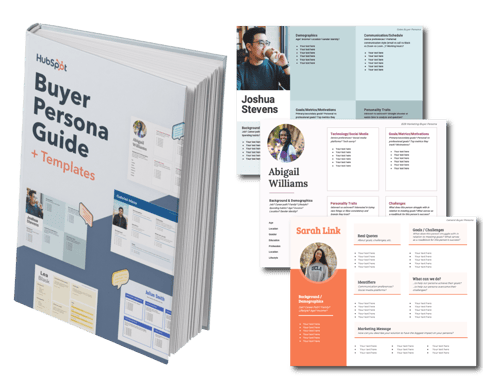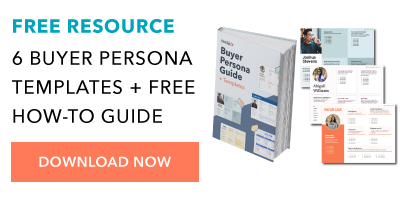Knowing your customers is a crucial component of successful inbound marketing. Get started with buyer persona questions that can help you understand customers’ mindsets.

We’ve gathered the best questions that can help you identify your audience. After you explore the answers, use this free buyer persona template to share your findings with the rest of your company. But first, let’s review the goals and benefits of carrying out buyer personal interviews.
The Goal of Buyer Persona Interview Questions
A buyer persona (or user persona) is a fictionalized representation of your target customer. But how do you know who that is unless you ask the right questions?
That’s where buyer persona interviews and surveys come in. Before creating your ideal buyer persona, it’s essential to choose a subsect of your existing customer base and deploy surveys that will help you understand their background and goals. You can also use a market research service, such as Qualtrics, to run panels and interviews with neutral participants.
Once you’ve decided whom you’re going to survey, you can use user persona questions to uncover the following information:
-
Demographics such as their age, education, occupation, and income
-
Psychographics such as their habits, beliefs, behaviors, and preferences (like shopping preferences)
This type of information can be endlessly beneficial to businesses and brands looking to convert more leads, personalize the customer experience, and improve their bottom line.
The Benefits of User Persona Surveys & Interviews
If you think you can guess at your ideal customer’s demographic and psychographic information, you may be right — after all, most of us are a buyer persona to another brand and can generally guess at the qualities of our customers.
However, if you’re looking to systematically convert more leads, then it’s essential to carry out formal persona interviews. Only then can you create a buyer persona profile that accurately depicts your typical customer.
These are only a few of the benefits of persona surveys:
Convert More Leads
Knowing your customers’ typical challenges and needs is key to appropriately targeting them and converting them. When you uncover your target audience’s descriptors and habits through persona interviews, you can more accurately target your sales and marketing campaigns to the users most likely to buy from you.
Personalize the Customer Experience
Personalizing the customer experience is one of the best ways to capture customers’ business and keep it for the long term. If they feel like you’re speaking directly to them, they’ll be more likely to buy from you. Get to know them first through persona interviews, and you’ll be able to make them feel like they’re the only customer you serve.
Improve the Bottom Line
When you convert more leads, you improve the ROI of your marketing campaigns and sales efforts. When you personalize the customer experience, you’re more likely to retain customers and increase repeat sales. These results improve the bottom line at your company, proving the effectiveness of your marketing and sales efforts.
Remember: you’ll need a content marketing strategy to reach your buyer personas. Find out how with HubSpot Academy’s free content marketing training resource page.
Buyer Persona Questions
- Describe your personal demographics.
- Describe your career path.
- Describe your educational background.
- What is the size of your company?
- In which industry or industries does your company work?
- What is your job role? Your title?
- To whom do you report? Who reports to you?
- Which skills are required to do your job?
- What does a typical day look like?
- How is your job measured?
- What knowledge and tools do you use in your job?
Download our free buyer persona template here to learn how to create buyer personas for your business.
Questions About Their Personal Background
1. Describe your personal demographics.
Collecting demographic information is a great place to begin drafting your personas. These questions paint a clearer, more personal picture of your customer.
Understand what communities they are a part of, and how those identities impact their interaction with your brand.
What to Look for in the Answer
Are they married? What’s their annual household income? Where do they live? What are their cultural and racial backgrounds? What is their gender identity? How old are they? Do they have children?
2. Describe your career path.
Having an idea of your client’s background tells you a lot about the type of information that they consume and the problems that they can face regarding their work. This can be especially helpful if you sell a B2B product.
What to Look for in the Answer
How did they end up where they are today? Has their career track been pretty traditional, or did they switch from another industry?
3. Describe your educational background.
Get specific here. “Boston University” is better than “liberal arts college.” Where a person went to school can impact their worldview. That includes both the size of the college, their major, and the location of the school.
What to Look for in the Answer
What level of education did they complete? Which schools did they attend, and what did they study?
Questions About Their Company
4. What is the size of your company?
Keep an eye out for specific details about the company. The size of a business impacts how many people use your product, as well as the way they use your offering. Understanding the amount of revenue can help you set appropriate pricing.
Knowing details about your persona’s company, like the number of employees, will help you when you’re building the fields for your landing page forms.
What to Look for in the Answer
How many people work at the company? How much revenue does the company generate? How many customers does the company serve?
5. In which industry or industries does your company work?
The answer to this question isn’t the department in which your buyer persona works. Your buyer persona’s industry is the type of service they deliver to their clients, and knowing this can help you measure your business’s impact in the markets you’re targeting.
Depending on the challenges your buyer persona faces, it might also be worth getting information on the industries your client’s business serves, not just the actual service they provide.
For example, if your buyer persona provides renewable energy plans for hospitals. They are in the environmental services industry for education and medical customers.
What to Look for in the Answer
What sector do potential buyers work in? Are they in a broad industry like healthcare or insurance? Are they in a more niche market?
Questions About Their Role
6. What is your job role? Your title?
The importance of your buyer persona’s job depends on the product or service you’re selling.
If you’re a B2C company, you may simply consider this information as another way to better understand the nuances of your persona’s life.
If you’re a B2B company, this piece of information becomes more crucial. Is your persona at a managerial or director level, and well versed in the intricacies of your industry? They’ll need less education than someone at an introductory level, who may need to loop in other decision-makers before making purchasing decisions.
What to Look for in the Answer
How long have they had this role and title? Are they an individual contributor, or do they manage other people?
7. To whom do you report? Who reports to you?
If you have a B2B offering, knowing your buyers’ seniority levels is especially important. This information can help your sales team understand who prospects might be.
For B2C companies, your users’ seniority level can give you insight into their lifestyles. Do people spend most of their time in the office? Are they often in meetings? That will impact when and where they use your product.
What to Look for in the Answer
How senior is your buyer? How many people work for them? Where are they in the larger organization?
8. Which skills are required to do your job?
If they were hiring someone to replace them and had to write a job description of what’s required, what would it say? Understanding your buyer’s skillsets can help you understand the level of training they need when using your product.
Or perhaps, your product is intended to supplement a skill they lack. Knowing where their strengths are can help you focus your product development efforts.
What to Look for in the Answer
What are the ideal skills for this job, and how good is your persona at each of them? Where did they learn these skills? Did they learn them on the job, at a previous job, or by taking a course?
9. What does a typical day look like?
This should include both the tasks they do for their job, as well as what happens during the day outside their job. Knowing your personas’ schedules can help you understand when they use your offering. That holds true for both B2B and B2C products.
What to Look for in the Answer
For their time in the office, look for the following.
- What time do they get to work and what time do they leave?
- What do they do when they’re most productive?
- What’s their “busy work” look like?
For time spent outside of the office, take note of the following.
- Are they spending more time at work or at home?
- Where would they rather be?
- What do they like to do for fun?
- Who are the people in their life that matter most?
- What kind of car do they drive?
- Which TV shows do they watch?
- Heck, what outfit are they wearing? Get personal here.
10. How is your job measured?
You should know what metrics will make your user successful, and what they might be worried about when it comes to “hitting their numbers.” This can help your marketing team identify which features to highlight.
What to Look for in the Answer
Which metric(s) is your persona responsible for? Which numbers or charts or waterfall graphs do they look at every day?
11. What knowledge and tools do you use in your job?
Understanding what products they love (and hate) to use can help you identify commonalities in your own product (and adjust your positioning accordingly). You can also understand how your product integrates with their pre-existing tech stack.
What to Look for in the Answer
Which applications and tools do buyers use every single day? Every week? How much do they like these existing tools?
Questions About Buyer Goals
12. What are you responsible for?
This goes beyond the metrics they’re measured on. Your team should know what their primary job responsibilities are. With this knowledge, you can better explain how your offering makes buyers’ lives easier.
You can also identify ways to help your persona achieve their goals and overcome their challenges.
What to Look for in the Answer
What’s their primary goal at work? What about their secondary goal? What are their daily responsibilities? Quarterly responsibilities? Annual responsabilities?
13. What are your biggest challenges?
You’re in business because you’re solving a problem for your target audience. How does that problem affect their day-to-day life? Go into detail, and focus on the nuances that illustrate how that problem makes them feel.
For example, let’s say your company sells personal tax software directly to consumers. One of your personas may be a first-time tax preparer. What are the pain points of first-time tax preparers? They’re probably intimidated by the prospect of doing their taxes by themselves for the first time, overwhelmed by a tax code they don’t understand, and confused about where to start. These pain points differ from those of a seasoned tax preparer.
Try coming up with real quotes to refer to these challenges. For example, “It’s been difficult getting company-wide adoption of new technologies in the past,” or “I don’t have time to train new employees on a million different databases and platforms.”
What to Look for in the Answer
What are the different challenges for demographics? How do pain points vary by seniority and experience level? How do these challenges affect their daily life?
14. What does it mean to be successful in your role?
Companies that take the time to understand what makes their personas successful will likely enjoy more effective communications from both the sales and marketing teams.
What to Look for in the Answer
What can you do to make your personas look good? What features of your product already help them achieve their goals?
Questions About How Buyers Learn
15. How do you learn new information for your job?
If you’re going to market and sell to these personas, you need to understand how they consume information. Dive into their required upskilling at work, as well as the professional development your buyer individual sought. Your goal should be to best understand their learning style.
What to Look for in the Answer
Do they go online, prefer to learn in person, or pick up newspapers and magazines? If they’re online learners, do they visit social networks? To Google? Which sources do they trust the most — friends, family, coworkers, or industry experts?
16. Which associations and social networks do you participate in?
You should already be investing time and resources in social media marketing. Identify the associations and social networks where your buyers spend their time. Then, you can prioritize which accounts to create and which conversations to participate in.
What to Look for in the Answer
What in-person or community-based gatherings do buyers attend? How are these gatherings promoted? What do they learn from these events?
What social media platforms do your buyers prefer? How much time do they spend on these platforms? What platform features do they actually use?
17. Which publications or blogs do you read?
To piece together a typical day in their life, figure out where they regularly go to stay informed. If you know how they prefer to gather information, you can make yourself present in those spots. The next step is to establish credibility in those communities.
What to Look for in the Answer
What magazines or news outlets do they read? Are there blogs they frequent? Which trusted thought leaders do they turn to?
Questions About Their Shopping Preferences
18. Describe a recent purchase.
You should understand your buyers’ evaluation process when making a purchase. How do they decide what they buy?
If you can anticipate the objections your persona will have, you can be prepared for them in the sales process. You will also be able to educate them in your marketing collateral to help allay fears right away.
What to Look for in the Answer
Why did you consider a purchase, what was the evaluation process, and how did you decide to purchase that product or service?
Is this their first time purchasing a product or service of your kind? If not, what caused them to switch products or services? What might make them reticent to buy from providers in your industry?
19. Do you use the internet to research vendors or products? If yes, how do you search for information?
These questions will help you determine which sources of information your buyer trusts. This can help you identify what type of reviews you would like to elicit. You can also plan your marketing collateral appropriately.
What to Look for in the Answer
Which avenues are they using to find new information? Do they search online, look at review websites, ask their friends and family, or do something else?
20. How do you prefer to interact with vendors?
You should know the best ways to get in touch with potential buyers. From there, you can understand how they want to interact with you — as well as how frequently. The experience of purchasing your product should align with your persona’s expectations.
What to Look for in the Answer
What should their sales experience feel like? Is it consultative? How much time do they expect to spend with a salesperson? Do they anticipate an in-person meeting, or would they rather conduct the sales process online or over the phone?
What’s next?
Once you’ve gone through this exercise and worked out any lingering questions about what makes your persona tick, browse through some stock imagery and find an actual picture to associate with your persona. Going through this exercise forces you to clarify an image of your target audience in your entire organization’s mind that will help keep your messaging consistent.
Another useful exercise is to practice being able to identify your buyer persona so you can tailor your communications. How will you know when you’re talking to this persona? Is it their job title?
Once you’ve established not only who your persona is, but also how you can identify them when you encounter one or another, your employees will be able to maintain a consistent voice that is still customized to each person they talk to.
Then, use our free, downloadable persona template to organize the information you’ve gathered about your persona. Share these slides with the rest of your company so everyone can benefit from the research you’ve done and develop an in-depth understanding of the person (or people) they’re targeting every day at work.
Source link






![Blog - Buyer Persona Template [Updated]](https://no-cache.hubspot.com/cta/default/53/36f0bd21-f25e-4906-9451-b84452a7ab7d.png)

